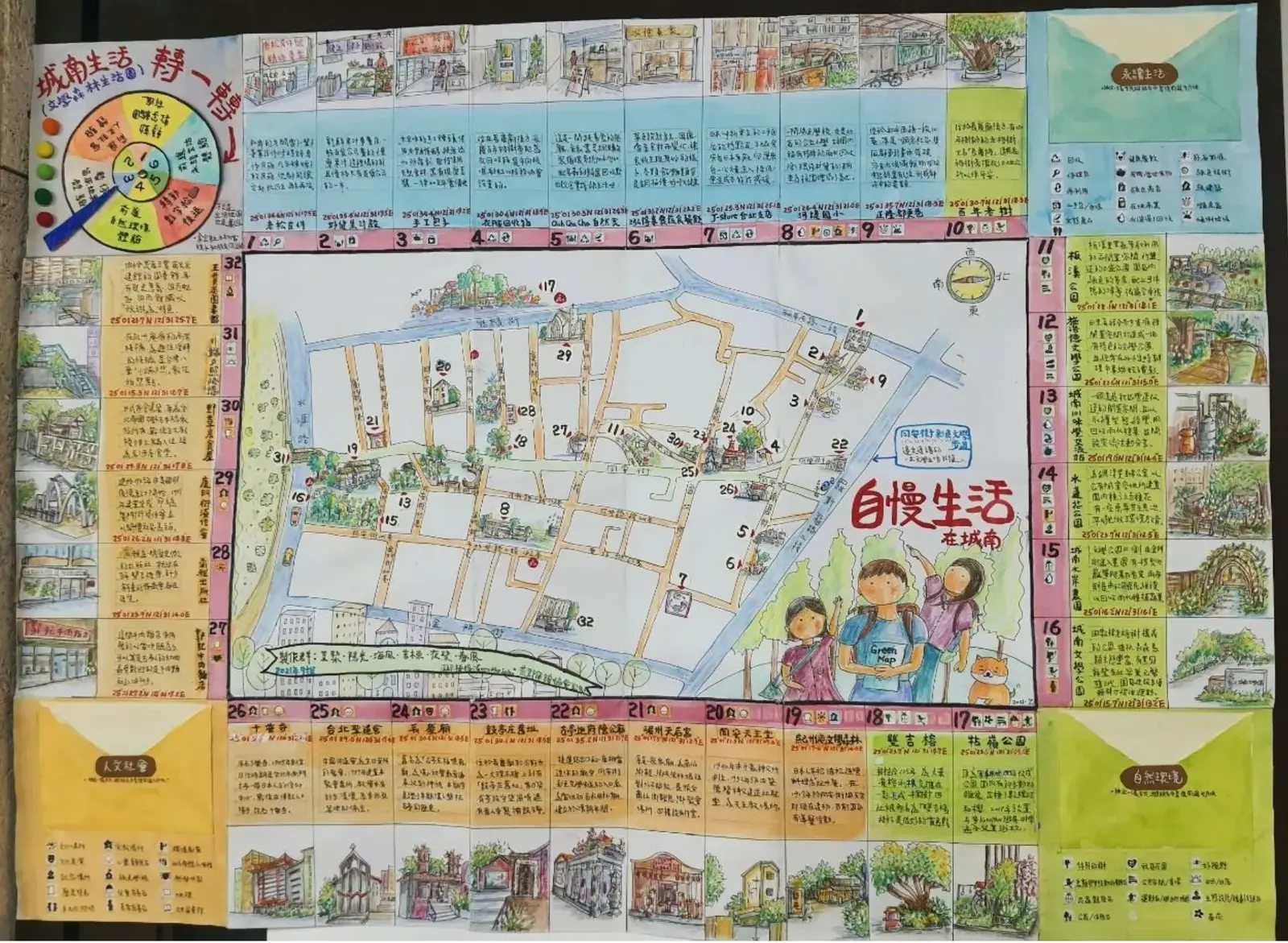We received two articles from the wonderful team at Society of Wilderness! Mika Shen shares her experience and a team leader, Boylin provides background (and some of the cool products created in Taiwan to support this effort)! We encourage you to download the each of the PDFs and view how images and languages were arranged together in the articles.
Do you have a Green Map for yourself or your community?
by Mika Shen, SOW Green Map team volunteer and Taiwan Citizen Journalist (original post)
I have been continuously searching for a way to engage in sustainable conversations within organizations, communities, or my own life. During my search, I came across the Green Living Map Workshop organized by the society of Wilderness (SOW).
你有一張自己或社區的綠色生活地圖嗎?
文圖/沈秀娟(台灣荒野綠色生活地圖志工;公民記者-宇宙)20240611
我持續地在尋找是否有一個方式在組織、在社區或自己的生活中能與永續對話,找著找著就看到了荒野台北舉辦的綠色生活地圖工作坊。
(照片: 荒野台北綠色生活地圖工作坊創作-台北城南)
This is a 9-day workshop. At Wufen Port Creek, which boasts a rich ecosystem with birds such as herons, kingfishers, and black bulbuls; plants like the blood tree and Chessboard flower; and also crabs, frogs, and fish. The area faces issues such as dams, irrigation, and sewage discharge. In Shumeikeng Creek, there is a history of Pingpu tribes' migration, Han Chinese settlement, the establishment of irrigation systems during the Japanese colonial period, development of drinking water, industrial pollution, and urban development
issues.
這是一場9天的工作坊,在五分港溪,有豐富的生態鳥類:如蒼鷺、翠鳥、紅嘴黑鵯等;植物:如血桐、穗花棋盤腳等;有螃蟹、蛙類、魚類等,也有大壩、灌溉與汙水排放問題。在樹梅坑溪,有平埔族的遷徙、漢民開墾、日治時期的灌溉系統建置到飲用水開發到工業化汙染與都市開發問題。在板橋城認識林家花園與在地關係、廟宇的歷史與居民信仰、在地組織如何喚起板橋人對自己生活圈的關心。在台北城南認識當年繁榮的盛事,文人與出版業的興起、現今城市與建設的變化。在永春陂生態濕地公園看到各項資源對於生態復育與環境教育的努力。在清水湖環境教育基地體驗社會團體對於溼地與環境的倡議與教育推廣,也看到在地人高齡社會及口流失等等問題。
(照片: 荒野台北綠色生活地圖工作坊創作-樹梅坑溪環境教育)
In Banqiao City, we learned about the Lin Family Garden and local relationships, the history of temples and residents' beliefs, and how local organizations encourage Banqiao residents to care about their living environment. In South Taipei City, we explored the past prosperity, the rise of scholars and publishing, and the current changes in the city and its constructions. At Yongchunpi Ecological Wetland Park, we saw efforts in ecological restoration and environmental education. At Qingshui Lake Environmental Education Base, we experienced social groups' advocacy and educational promotion for wetlands and the environment, and also noted issues such as an aging society and population loss in the area.
透過綠色生活地圖工具活動探索城市到鄉間的地理、歷史與人文發展,不只發現了這些場域的樣貌,綠活圖所設計的170個圖示icon,包含正面的與負面的圖示,讓你連結了場域與環境的文化、社會、自然和永續的關係~
除了親自踏訪不同的場域繪製出他們的綠活圖外,工作坊的課程設計還有綠活圖遊台灣、永春陂桌遊、用科技闖關城南實境遊戲、植物拓印等,你可以學習有各種方式來展現綠色生活地圖。關於與參加者自己的生活的連結就是畫出你社區和家中的綠色生活地圖。在學習成果上的展現是設計一套教學或攤位展的教案,各組找一個場域作出它的綠色生活地圖。從基本知識、體驗式學習到思考,到對話或內化成為自己的技能或成為下一個可以永續發展的專案去實踐~
(照片: 荒野台北綠色生活地圖工作坊創作-城南景點手繪圖)
The Green Map System was founded in 1995 by Wendy Brawer in the United States, designed for community sustainable development. Over the past 29 years, it has expanded to 65 countries worldwide. Wilderness Taipei collaborated
with them from the start to bring this initiative to Taiwan. For over 20 years, they have conducted numerous instructor training workshops and promoted the concept in schools, organizations, and enterprises, creating their own Green Living Maps.
This is a set of tools that anyone or any organization can undertake: selecting an area → understanding the 170 green icons → conducting field surveys → identifying green icons in the field → drawing the map → sharing the map. Each process directly or indirectly connects people with sustainable development. Do you want to have your own Green Map? You can start by joining this workshop to learn or experience it, then freely create a Green Living Map for sustainable development.
(照片: 荒野台北綠色生活地圖工作坊創作-清水湖環境教育基地綠活圖
綠色地圖系統Green Map是1995年由美國溫迪·布勞爾(Wendy Brawer)創辦, 是為了社區永續發展而設計。在這29多年來已拓展到世界65個國家。荒野在他們創辦之初便與他們合作申請授權來台灣推廣,這20多年來辦了多場講師訓練工作坊,也到學校、組織或企業去推廣,他們創造了屬於自己的綠色生活地圖。
這是任何人或組織都可以著手進行的一套工具,從選定區域→認識170個綠色標示icon→實地踏查場域→找出場域中的綠色標示icon→繪製地圖→分享地圖。每一個過程都在直接或間接的串起人們與永續發展的連結。 你想想要有一張自己的綠色生活地圖嗎?你可以從這個工作坊開始認識或體驗,然後自由自在地創造一張可持續性發展的綠色生活地圖。
-=-=-=-=-
Draw a map to save the earth ?by Boylin, SOW Green Map team leader - - this article appeared here originally
Can drawing a map save the planet? Turning off the lights can save polar
bears, using fewer plastic bags can save sea turtles, reducing waste can save
entire oceans, and drawing a "Green Map" can save the whole world!
In 1992, Wendy Brawer created the world's first "Green Map" (Green Apple
Map). At that time, she simply marked "green living spots" on the map with
small icons, which attracted 315 maps from 46 countries worldwide to join
the initiative!
https://www.sow.org.tw/blog/20230703/43101
What exactly are "green living spots"? Simply put, they are locations that
help save the Earth. For example: restrooms. In addition to relieving your
bladder, restrooms with water-saving faucets, sensor flushing systems, watersaving
flush devices, and rainwater recycling systems are all great ways to
save the planet. Every time you use such a restroom, you are helping to save
the Earth.
Naturally, these kinds of "green living spots" should be clearly
marked on the Green Map, so that anyone who sees the map can also "save
the planet by using the restroom"! Another example is train stations. Trains
are part of the public transportation system, and you can take your bike on
board, plus there's free Wi-Fi available. In Taiwan, you can cycle around the
island while taking trains, and at the stations, you can go online for free,
check-in, and share your eco-friendly journey with the world! These "green
living spots" should also be clearly marked on the Green Map, allowing
everyone who sees the map to "tour Taiwan and save the planet"!
So, is drawing a Green Map difficult? Honestly, it can be quite challenging!
But thanks to Wendy Brawer's systematic organization, creating a Green Map
has become much easier. Even elementary school students can do it! This is
why the promotion instructors from the "Wilderness Conservation Society
Green Map Group" always receive enthusiastic feedback when they visit
schools:
"I didn't know our school had so many green living spots!" "I had no
idea our community was so beautiful!" "I've lived here for over 10 years and
never knew there were such great green living spots!"
The process of drawing
the map is full of surprises! Consequently, after finishing the map, everyone
develops a deeper appreciation and love for their native environment. This is
the greatest achievement for us promotion instructors! We hope that through
the Green Map, people can discover from their everyday surroundings that
our living environment is truly wonderful; you just need to pay attention to
notice it!
Come on! Join us in "drawing maps to save the planet"!












